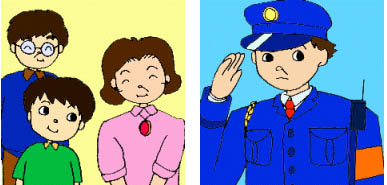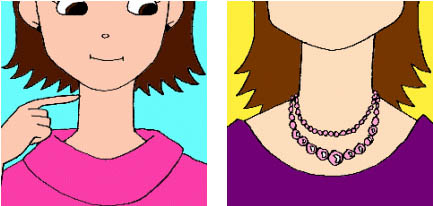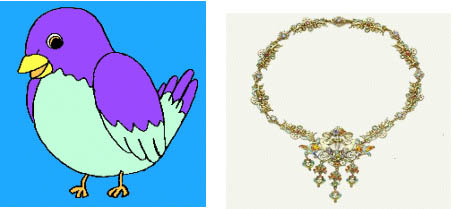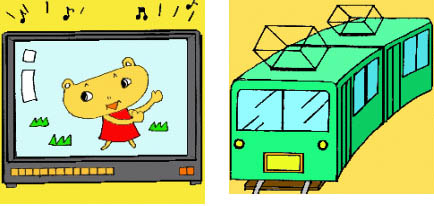 设为首页
设为首页
 加入收藏
加入收藏
本单元重点例句及相关知识讲解与分析
1. Someone has stolen my necklace. 有人偷走了我项链.
(1) someone = somebody 某人、有人、属于不定代词,只有单数形式。
(2)somebody还解释为“重要人物”,这时它与不定冠词连用。
例:He’s nobody here in town but he’s a somebody in his own village. 他在这城市默默无闻,但在他本村中并非等闲之辈。
(3)stolen亦能作分词形容词,解释为“被偷走的”。
2.He said, “Hands up! …” 他说,“把手举起来!……”
Hands up的意思是“举手”。Hand和不同的介、副词放在一起具有不同的含义,要注意总结。例如:
hand in 上交,交给 hand down 传下来,公布
hand on 传给,传下来 hand out 分发,提供
hand over 传(某物)给某人,交出
3.Who would you ask for help if you were robbed?
如遭受抢劫,你会找谁寻求帮助(向谁求助)?
(1)在本句中,would ask并非过去将来时,were并非过去时,而是一种虚拟语句表示一种不大可能发生的假设)的表现形式。
例:If I were you,I would tell the truth.如果我是你,我就会讲实话了。(但是我不是你)
(2)ask(sb)for help(向……)求助。
(3)rob(动词)抢劫、剥夺,其常用句型是rob sb. Of sth.抢去/剥夺走某人的……
例:That bank was robbed yesterday. 昨晚那银行被劫。
robber(名词)劫贼,robbery(名词)抢劫。
注意下面两句的区别。
I was robbed of my watch.我的手表被抢走了。
I had my watch stolen.我的手表被偷走了。
4.There is no need to thank me. 不用谢我。
There is(no)need to do sth.= have(no)need to do sth.表示必须/不必做某事。need在句中作名词表“需要;缺少,贫困”的意思。也可以作及物动词或情态动词,表“需要,必须”的意思。但需要注意的是:
(1)need作情态动词只用于否定句和疑问句,通常不用于肯定句。
(2)didn’t need to do表示“不需要做某事”,而事实上也没有做;needn’t have done则表示已经做了某事,而事实上“不需要做”,是虚拟语气用法。例如:
(1)He felt the need of a better education.他感到有必要受到更好的教育。
(2)She helped me in my hour of need.她在我困难的时候帮过我。
(3)He needs a new coat.他需要一件新外套。
(4)Need they have sold the farm?他们那时非得把农场卖掉吗?
5.Jim noticed it about an hour ago.吉姆半个小时前注意到了这件事。
notice在句中是及物动词,表“注意,观察到,看到”的意思。notice sb.to do sth.表示“注意到某人做某事”;notice sb.doing sth.则表示“注意到某人正在做某事”。其也可以当名词用,表“通知,布告,通告,注意”的意思。例如:
(1)I noticed him dig a hole in the wall.我注意到他在墙上挖了一个洞。
(2)The cook left without notice.那厨师没有预先通知就走了。
在英语中,see,look,watch,notice都有“看”的意思,要注意他们的区别。
see意为“看到”,表示视觉器官有意识或无意识地看到物体,强调“看到”的结果。
look意为“看”,表示有意识地观看,强调“看”的动作。
watch意为“观看,注视”,指以较大的注意力观看。
notice意为“看到,注意到”,指有意识的注意,含有从不注意到注意的变化的意义。又如:
(1)What can you see in the picture?在图画中你能看到什么?
(2)Look! How happily they are playing!看!他们玩得多高兴啊!
(3)He’s watched TV for over two hours.他看了两个多小时的电视。
(4)He noticed a purse lying on the road.他注意到地上有个钱包。
6.But when he went to feed her today, she’d gone.
但他今天去喂她时,她已不见了。
本句中的’d是had,had gone是过去完成时。它相当于had disappeared,或was missing或was gone。
7. When was the last time you saw the parrot?
句中的time不是指时间,而是指“次数”。后面的you saw the parrot是定语从句,是省略了关系代词that的定语从句,用修饰time的。
【例】(1)The car which/ that my uncle bought last month is very fast.
我叔叔上个月买的那辆车速度很快。
(2)The house which/ that we live in is very old.
我们住的房子很旧。
(3)Is that the parrot you are looking for?
那是你要找的鹦鹉吗?
8.I'm afraid your parrot has seen too many films about stealing.
我怕你的鹦鹉看了太多的有关偷窃的电影。
句中too many是“许多、太多”的意思,其后接可数名词复数形式;too much也是“许多、太多”的意思,其后接不可数名词;much too是“很、非常”的意思,其后接形容词或副词。
【例】(1)There are too many books in your son's bag.
你儿子书包里的书太多了。
(2)She drank too much water.
她喝了太多的水了。
(3)Big computers are much too expensive.
内存大的电脑太贵。
9.We have caught a man who matches Miss Shirley Brown’s description. 我们已逮到了一个与Shirley Brown小姐的描述相符的人。
本句中的match是动词,是“与……相配、相符合”的意思。
match还能作名词,解释为“火柴、比赛”等。
description(名词)解释为“描述、形容”,动词是describe。
例:Can you give me a description of the thief? 你能说出那贼的模样吗?它等于Can you describe the thief?
语法:定语从句(The Attributive Clause)
在复合句中,修饰某一名词或代词的从句叫做定语从句。
【例】
(l)The man who lives next to us sells vegetables.
(2)You must do everything that I do.
上面两句中的man和everything是定语从句所修饰的词,叫先行词,定语从句放在先行词的后面。
引导定语从句的词有关系代同that,which,who(宾格whom,所有格whose)和关系副词where,when。关系代词和关系副词放在先行词和定语从句之间,起联系作用,同时又作定语从句的一个成分。
l)由关系代词引导的定语从句:
①that在从句中可作主语或宾语,指物或指人。
【例】A plane is a machine that can fly.
Who is the man that is reading a book over there?
②which在从句中可作主语或宾语,指物。
【例】They planted the trees which didn't need much water.
The fish which we bought were not fresh.
③who,whom在从句中分别作主语和宾语,指人。
【例】The boy who broke the window is called Tom.
Mrs Read is the person to whom you should write.
2)由关系副词引导的定语从句:
①when指时间。
【例】I’ll never forget the time when we worked on the farm.
②where指地点。
【例】This is the house where we lived last year.
注:1.that和which在从句中作主语时,不能省略;作宾语时,在口语和非正式文体中经常省略。whom也常可省略。
2.关系代词that在定语从句中作介词的宾语时,介词不能放在它的前面,只能放在从句中有关动词的后面。
【例】The village that she lives in is twenty kilometres away.
关于第65课定语从句的教学建议
第65课是一段对话,通过妻子向丈夫述说有人偷了她的项链的事情。这一课的语法重点是由关系代词who, that引导的限定性定语从句。有讲解相关的知识时,可设计图文并貌的教学过程,帮助学生理解和掌握定语从句这一语法难点。
先给出一个小男孩Tom的图片,提供以下词汇:

the handsome
the tall
the strong
the clever
the naughty
用以上的词汇来描述Tom,形成如下句子:
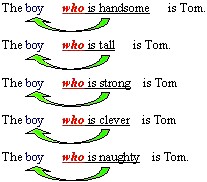
综述以上的句子,who在句中指小男孩Tom,在句中作定语,它引导的句子就是定语从句。
请看以下有关定语从句的例句:
1.The boy is Tom. The boy has a round face.
The boy who is smiling is Tom.
(主语)
2.The boy is in the lab. You want to talk to him.
The boy (whom) you want to talk to is in the lab.
The boy to whom you want to talk is in the lab.
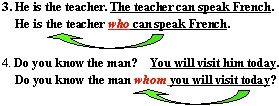
以上例句中的who 可以用that 来代替,在定语从句中that可以指人或物,代替who,whom,which;在从句中可以作主语、宾语,但不能放在介词后作介词宾语。如:
This is the photo that (which) I took in Beijing last year.
This is the man that/who lives next door.
Is this the professor that you talked about yesterday? (about不能放在that前面)
定语从句练习
Which boy do you like better?
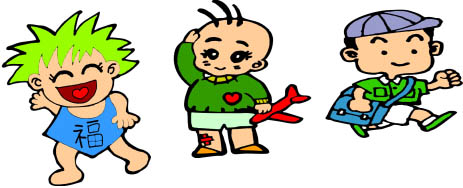

Answers list:
The boy who has a big mouth / has not shoes / has long hairs / with laughing.
The boy who wears a green sweater / has a plane / was hurt in his leg/ has little hairs / has big eyes.
The boy who has a blue bag / has a hat / has green shoes.
The boy who has red button / has purple shoes / is wearing a suit.
The boy who wears blue coat / has a red bag / has black shoes.
The boy who is smiling / who is naughty / has brown shoes.
课文Who stole the necklace 的教学建议
本单元第66课和67课的课文是一幕短剧。讲述了格林太太项链丢失后,发现是鹦鹉模仿劫犯的行为将项链取走的。教学中可考虑将这两课一起进行讲解。
先看展示剧情过程的一组图片,听课文的录音,熟悉课文内容。再讲解相关的词汇用法等知识。最后可根据这组图,让学生用自己的话复述课文。图片提供如下十幅:
